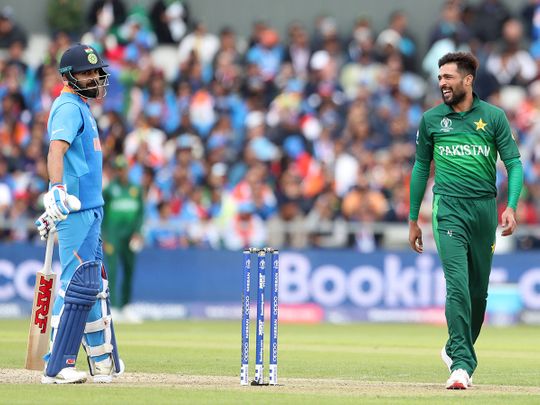
The corn did pop and there was no dearth of my favourite beverage on the upper tier of the Grand Stand. Not to mention of course the aroma from WG’s Whacking Great Sandwiches wafting all across the ground-floor sidewalks and assembly points. But for some reason, it felt as though the fizz wasn’t quite there. Walking down Cavendish Street and then entering the fabled Lord’s cricket ground in the heart of London, for an England-Australia round-robin match in the just-concluded cricket World Cup, this cricket fanatic’s conceptual-construct was replete with images of bitter cricketing rivalry that is legion between these two sides ever since the ashes urn was presented to visiting England captain Ivo Bligh during the 1882-83 tour of Australia, which came to be recognised as the sport’s most poignant moment and a rather dark symbolism for a crying need for soul-searching, unapologetically thrust upon the vanquished by the victor.
For the uninitiated, the term ‘Ashes’ was born out of a jocular ‘obituary’ published in a British newspaper in 1882, following England’s first defeat on home soil by a touring Australian cricket team. In a light-hearted jibe, the Sporting Times newspaper said English cricket would be burnt down and the ‘ashes’ sent to England. When the England team next visited Australia, the ‘ashes’ idea became a reality as a wooden bail was burned and the ashes put in an urn and presented to England captain Bligh.
The Ashes rivalry is considered to be cricket’s oldest and one of the most definitive sporting equivalents of an eye-for-an-eye. With time, as the lure of the sport spread beyond the threshold of the sacrosanct five-day format and into the increasingly abridged, instant-coffee versions of one-day Internationals and Twenty20s, any meeting between England and Australia on a cricket pitch anywhere in the world has come to be seen, measured, understood, appreciated, criticised and archived through the Ashes prism.
New brand of one-upmanship
Meanwhile, a bloody partition in August 1947, saw the emergence of a new brand of one-upmanship on the cricket field that would soon come to rival the Ashes in verve and panache: An India-vs-Pakistan anywhere on Planet Earth is little short of a duel of cosmic proportions.
In a nutshell, an India-Pakistan or an Australia-England is still one of the few reasons that have kept a colonial-era pastime retain its relevance for a generation that measures its time in money.
Having watched a couple of India-Pakistan encounters from ‘ground zero’ and in light of the recent England-Australia World Cup fixture at Lord’s, one is tempted to say that for any rivalry — whether sporting or political — to retain its fizz and emerge as a time-defying phenomenon, there ought to be some sort of a chaotic-carnivalesque character to it, to the extent that an Existentialist philosopher may even be tempted to goading one into submission into an “in-the-destructive-element-immerse” kind of a momentary indiscretion of one’s choosing — just to live life to the full, experiencing the inexplicable.
An India-Pakistan encounter watched from the terraces gives one ample scope to “immerse” oneself “in the destructive element” – if you know what I mean! An England-Australia match seen from the Lord’s Grand Stand, unfortunately, offers no such immersive ride. The former, a rivalry steeped in a shared sense of belonging to a chaotic-carnivalesque order. The latter, a contest too staid in its determination not to look beyond the immediacy of a day’s cricket out in the sun. The former, marked by heated off-the-cuff debates and light-hearted banter — sometimes even over a shared plate of nick-knacks. The latter, bereft of any on-the-stands debate whatsoever, but heavily laced with boos and taunts at rival teams at the drop of a hat.
Cricketing rivalry
Yes, an India-Pakistan cricketing rivalry is forever blessed by the bonds of a shared history, culture and 3,000km of border, which can never be the template for an England-Australia contest. Point granted. However, what is truly remarkable about an India-Pakistan cricketing rivalry is that though it is born by default out of a pure socio-political inevitability, the average fan on either side of the fence can and has shown the temerity to let cricket be the adjudicator where nuances of diplomatic and political propriety have often been found woefully wanting. On the contrary, though born out of a sense of pride — lost or won, as the case may be — based on a truth gracing the cricketing field and an enactment of truth through the comic-realism of presentation of the Ashes urn, the England-Australia scheme of things has remained what it has always been: A cricket historian’s treasure-trove of archival riches, steeped in symbolism and a sense of sporting pride and even nationalism to some extent, but never quite substance enough to fuel a cinematographer’s Oscar-night dream.
So on June 25, 2019, the corn did pop and there was a long queue at the souvenir store at Lord’s at the end of the England-Australia match. But strolling down the fan park, with English and Aussie fans seated next to each other on the lush green lawns, reminded me of J.B. Priestley’s essay Too Many People, where the celebrated author, talking about life in a big city, rues: ‘Never a knowing face, never an answering smile.’
When is the next India-Pakistan in Dubai?!








